X-Fi and the Elite Pro: SoundBlaster's Return to Greatness
by Derek Wilson on August 30, 2005 11:59 AM EST- Posted in
- Smartphones
- Mobile
Performance and Quality: Game Tests
For these tests, we will be looking at RightMark 3DSound 2.0 and Battlefield 2. With the possibility of twice the number of voices supported by Audigy, we can't do a direct comparison at some points. However, we will see how much impact going from 62 to 127 voices can have.Our test system included these components:
NVIDIA nForce 4 based motherboard
AMD Athlon 64 FX-55
1GB DDR400 2:2:2:8 RAM
NVIDIA GeForce 7800 GTX
120GB Seagate 7200.7 HD
Our RightMark tests show that the Audigy 4 Pro uses less CPU power per setting than the X-Fi. This was a little confusing at first, but we have our thoughts on why this happens. It seems to make sense to us that the X-Fi driver is more complicated than the Audigy driver. We therefore see slightly lower performance from the X-Fi card. With the X-Fi being brand new, driver improvements could also change the performance picture over time.
This performance issue should be different on the higher end X-Fi cards with games that support X-RAM. Unfortunately, we can't test this yet as no games we looked at have this ability. Storing uncompressed audio and not needing to run an MP3 or Ogg decoder in the background would help to significantly lighten the CPU load on most games. Note also how CPU usage increases nearly linearly with the number of voices used.
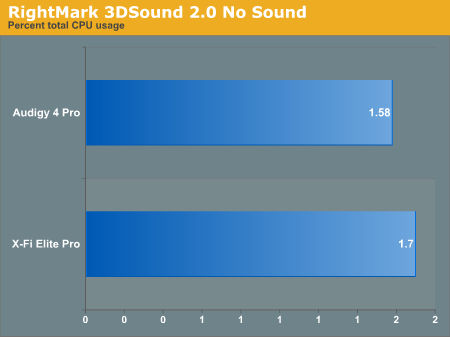
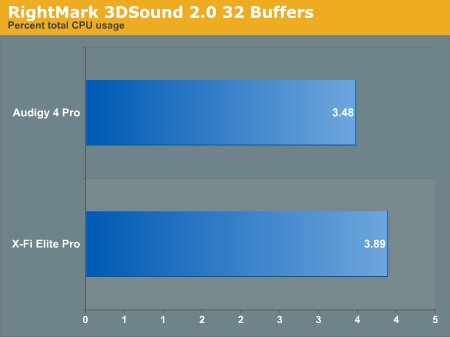
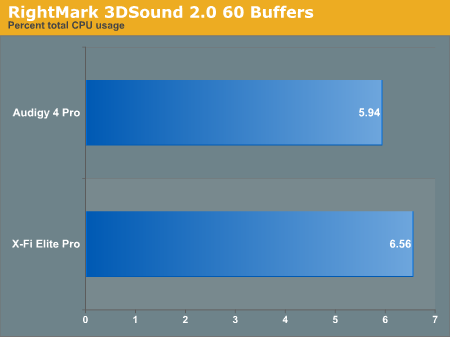
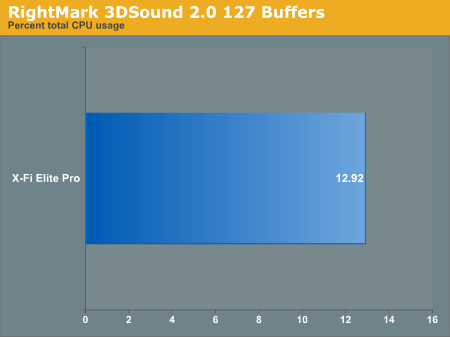
For Battlefield 2, we ran our usual test at medium quality settings at 1024x768. The Ultra High quality option in Battlefield 2 is only accessible with an X-Fi card (which likely means it employs more than 62 voices). As we can see, BF2 performance is consistent with our RightMark numbers. The X-Fi gives us just a little lower performance than the Audigy. It is nice to see that going from High Quality to Ultra High Quality on the X-Fi doesn't incur a significant performance penalty though.
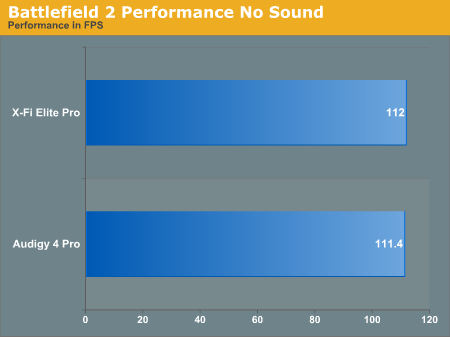
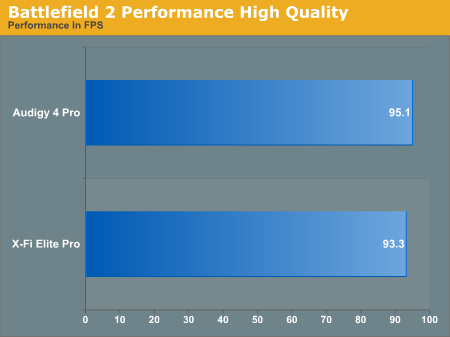
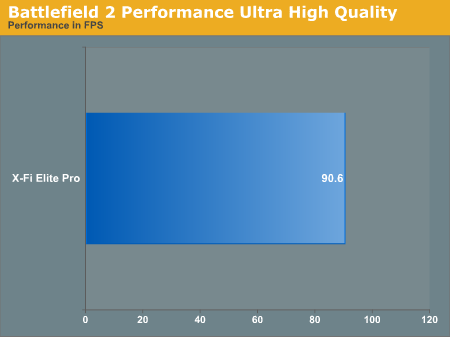










110 Comments
View All Comments
SDA - Wednesday, August 31, 2005 - link
>>For listening, I generally stick with my Sony MDR-7509 headset. I also have the Sennheiser HD580 that I use to audition sound hardware. The reason I stick with the Sony gear for general listening is due to my environment. I can turn everything off when I need to do a noise test or listen closely to something, but the lab with all the computers and workstations running is not a quiet environment. I realize that open air headests will reproduce (especially) the low end in a more appropraite manner, so I do listen with them, but I know the sound a little better on the MDR-7509s as I've been using them for a long time. >>Are either of those headphones being amplified? If not, you are probably putting unfair stress on the sound card's line out, and should at least compare with and without an amp (lots of sound devices sound great if not under undue stress). Also, consider getting monitor speakers to test surround sound output.. old Minimus-7s will do if you're on that tight of a budget (no bass whatsoever, but surprisingly neutral midrange and treble for small bucks and a small room), otherwise look around.
>>I am planning on picking up the HD650 as I've heard great things about them. >>
Enh, they're not different enough from the HD580 to warrant buying if you're looking for sound test gear. Get something with a different flavor first (Grado SR-225 or Alessandro MS-2 for high-current low-impedance rock phones, AKG K501 for analytical ridiculously inefficient mid-impedance phones), and get a reasonably good amplifier (no need for audiophile BS, just something with enough balls to run a K501).
>>Doing something like a double blind subjective study on audio is difficult. People that don't know how to listen won't be any help because even if they hear a difference they won't know how to describe it very well. People who do know what they are talking about are hard to come by in volume. Don't get me wrong, we'd love to do something like this. But we just don't have any idea how to work out the logistics. Suggestions are welcome. >>
Find three different people who know what they're talking about and aren't slaves to the placebo effect. Have them test the gear in a double-blind setting.
More specific advice... look for musicians. Especially look for musicians for testing songs heavy on specific instruments: someone who plays, say, the violin will know exactly what a violin will sound.
>>Also, I appreciate the suggestion to avoid general statements about the goodness of something. It is a good suggestion even in cases where we know everything about everything in detail. There are always surprises and erring on the side of caution is the best way to go. We will be more careful in the future. >>
And, fwiw, I appreciate the maturity and responsibility one gets from AT editors. (Yes, I can give compliments too!)
DerekWilson - Wednesday, August 31, 2005 - link
I am not sure if I want to go with active amplification. I understand that stressing the opamps on the card towards the top end of their range could adversly affect their linearity. But my impression is that spending this much money on an audio card means a listener should not have to invest in an amp to get the best quality sound. We want talk about the audio as it will be heard by our readers.Do you have a different opinion on the subject?
And thanks for the suggestions on speakers and other headsets.
SDA - Wednesday, August 31, 2005 - link
>>I am not sure if I want to go with active amplification. I understand that stressing the opamps on the card towards the top end of their range could adversly affect their linearity. But my impression is that spending this much money on an audio card means a listener should not have to invest in an amp to get the best quality sound. We want talk about the audio as it will be heard by our readers.Do you have a different opinion on the subject? >>
The amplifiers on sound card line-outs are rarely equipped to drive headphones, especially not extremely power-hungry one. While I agree there is value in an ampless test, I also feel that an amplifier would be a good idea for pure line-out performance. A lot of us don't put any real strain on the line-outs, after all, and I'd like to see how evening the playing field a little helps various cards.
At any rate, spending this much money on (insert piece of equipment here) never entitles a listener to avoiding another link in the chain entirely. Not that headphone amps are a necessity, but hooking a $200 headphone to a line-out of a $400 sound card is a little silly and probably wouldn't yield sound as good as a lower-tier sound card and a cheap headphone amp (the things don't need to be pricey, just gutsy enough to power any normal dynamic headphone with ease).
Xentropy - Wednesday, August 31, 2005 - link
Sorry this is a bit off-topic, but you seem to know what you're talking about, and everywhere else I've asked I've gotten audiophile answers (e.g. buy this or that $2000 piece of equipment), so......What reasonably priced headphone amp(s) can you recommend for use between a soundcard and a set of HD570's?
SDA - Thursday, September 1, 2005 - link
The PPA and M^3 are reasonably priced, at least from a DIY perspective. At a lower price point, PIMETAs are fine.If I were you, though, I would upgrade that HD570 first-- driver upgrade (meaning speakers or headphones) is generally much more noticeable than amp or source upgrade. If you like a bass-n-treble signature, try the HD590; if you like something bassy and trebley but with midrange in the bargain, try a Grado or Alessandro. A very simple amp / 'CMoy' (buy on Head-Fi or somewhere, they're overpriced on eBay) with a decent op-amp (OPA2134PA is fine) covers a surprisingly large amount of the gap between no amp and top-end amp-- the biggest thing is taking undue stress off of the sound card's line out.
Or, you know, buy a $3000 amplifier, and line it with sound-improving rainbow foil (hur hur hur).
mindless1 - Friday, September 2, 2005 - link
Personally I found an unbuffered design like a CMOY to be a more similar to a soundcard's line-out than to a Pimeta, PPA or M3... they're all fairly harsh with terrible channel separation.SDA - Friday, September 2, 2005 - link
What op-amp? An unbuffered design is bound to be heavily opamp-dependent.. I've heard some that I'd prefer a Sony D-33's headphone out to, and I've heard others that are 80% of a META42. A great op-amp might be terrible in an unbuffered design for current output reasons.mindless1 - Friday, September 2, 2005 - link
Just about any mid-grade or better? I find some of my favorites, like AD8610, AD843, and OPA637, all sound far better unbuffered than jellybeans like TL072 or old standards like JRC4556/8, BUT *almost* anything buffered beats them. Higher current chps like LM6171 give more current but still lack quality sound. I "almost" find completely dreadful, entirely unmusical general purpose opamps sound as good buffered as the average "good" opamps in an unbuffered configuration... and it doesn't even take much of a buffer to make that difference.This is of course keeping in mind the current limitations, they don't even sound very good at low output. IMO, a CMOY type design is only useful for higher Z cans that need a bit of a volume boost. Then again, vast difference in price too, some people have enough spare parts to crank out a CMOY on protoboard plus $10. CMOY is like a gateway drug, it only teased me onto harder habits.
SDA - Friday, September 2, 2005 - link
Wow... well, I guess our ears just disagree there, especially since the AD8610 is my favorite for unbuffered. I still prefer buffered, of course, I've just always felt that an unbuffered AD8610/20 or similar CMoy-type amp covers a good chunk of the gap. Well, each to their own, I suppose, and AT editors should be looking for something higher-end anyway.mindless1 - Thursday, September 1, 2005 - link
Well, LOL."Audiophile" <> reasonably priced... never has and never will.
However, a ballpark $200 headamp might be a "PPA v2" custom-built with AD843 opamps rolled in. Thee are a few lists of trade builders for PPA2 or other customizable amps that you can DIY, actually tailor to your cans, or to your tastes, there is a vast gulf between gamer pseudo-audiophiles that buy Creative Labs cards with digital tricks and those who simply want cleanest analog possible and bit-perfect digi out. Wheverver you fit into the grand scheme, may dictate the optimal amp for you.
Then you'll want another amp, and more cans, and another sound card, and a DAC, and... Sorry about your wallet. ;-)